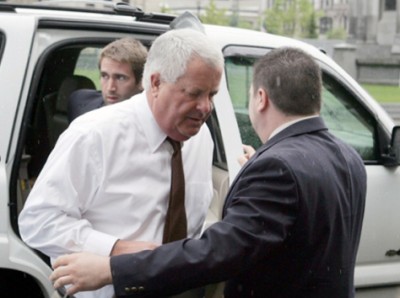According to the National Institute on Drug Abuse more than 2.5 million people receive treatment each year from “for profit” drug rehabilitation facilities. Many of those being treated are minors.
The following is a chart of the type of drugs that are being consumed today. More than 50% is marijuana, with nearly 25% of drug abuse being related to pain relievers. Pain relievers are legal sources that often result in worse addictive problems than illegal “drugs” such as marijuana.

Concerned parents should be aware because many of these “treatment” facilities are experimental, non-licensed, controversial, and may offer little or no real professional support. Inevitably, many of these facilities can, and do cause more harmful long-term effects than the issue they had been monetarily compensated to alleviate. In a worse case scenario, several of these institutions have sent a child home in a way the ill-informed parents never conceived. Dead!
Court involvement
The court system should be the last thing a parent utilizes in their effort to obtain help for their children. The result could be that the parent loses their fundamental right to make decisions regarding their child’s health and well-being.
The issue of children’s rights is poorly defined in legislation and by the courts, partly because U.S. society as a whole has not decided how much autonomy to grant children. Although the U.S. is built on protecting the interests of individuals and the twentieth century saw the rights of people with special needs recognized, the nation has yet to extend to children legal standing (the right to bring a court case) and legal protection similar to that of adults.
Parents often seek to use the services of the court to help them incarcerate their children, and do so believing they are helping that child. In reality, the parent is placing trust in a system that will give their child a criminal record, place them on probation, and ruin their child’s educational path. Alarmingly, many children that are court ordered into these “for profit” programs have little or no governmental oversight once the child is remanded.
Some judges and prosecutors have even been caught accepting bribes for ushering scores of children into these human warehouses, thus violating the child’s right to receive a fair hearing.
Read the Kids For Cash Scandal that blew the lid on the entire industry:
http://en.wikipedia.org/wiki/PA_Child_Care.
http://en.wikipedia.org/wiki/Kids_for_cash_scandal.
PA Child Care is infamous for its involvement in the Kids For Cash Scandal. Judges Michael Conahan and Mark Ciavarella pled guilty to receiving $2.6 million in payments from PA Child Care in return for imposing harsh sentences on juvenile offenders in order to ensure that the detention centers would be utilized.

Former disgraced judge Mark Ciavarella, and former Luzerne County Judge Michael Conahan were found guilty of taking kickbacks to supply private detention facilities with scores of juveniles who were denied fair hearings.

Former disgraced Judge Michael Conahan arrives at the Willian J. Nealon Federal Courthouse where he plead guilty to racketeering charges.
In July 2009, Robert Powell the founder of PA Child Care pled guilty to failing to report a felony and being an accessory to tax evasion conspiracy in connection with $770,000 in kickbacks he paid to Ciavarella and Conahan in exchange for helping to facilitate the development of his scam. Powell’s law license was suspended following his criminal conviction.
Keep in mind that the same U.S. court system only a few years ago had no problem ordering the execution of a minor.
In Roper v. Simmons, 543 U.S. 551 (2005), the Supreme Court held that the Constitution forbids the execution of minors when they committed their crimes, ending a practice that had been used in nineteen states. The 5-4 decision throws out the death sentences of about seventy juveniles and bars states from seeking to execute minors for future crimes. The executions, the court said, were unconstitutionally cruel.
Informed consent
A child that is placed in one of these treatment facilities is a medical patient under the eyes of the law. When you make a decision to place your child in one of these facilities you will be leaving a paper trail of your child’s treatment for drug and/or alcohol abuse. This could come back to haunt a parent when it comes time to apply for a college, vocational program, a job, or military service.
Informed consent is a legal document used in all fifty states. It is an agreement for a proposed medical treatment procedure. It requires physicians to disclose the benefits, risks, and alternatives to the proposed treatment, non-treatment, or procedure. It is the method by which fully informed, rational persons may be involved in choices about their (their child’s) health care.
Informed consent stems from the legal and ethical right an individual has to decide what is done to their body, and from the physician’s ethical duty to make sure that individuals are involved in the decisions making processes. The process of securing informed consent has three phases, all of which involve information exchange between doctor and patient and are part of patient education.
First, in words an individual can understand, the physician must convey the details of a planned procedure or treatment, its potential benefits and serious risks, and any feasible alternatives. The patient should be presented with information on the most likely outcomes of the treatment.
Second, the physician must evaluate whether or not the person has understood what has been said, must ascertain that the risks have been accepted, and that the patient is giving consent to proceed with the procedure or treatment with full knowledge and forethought.
Finally, the individual must sign a consent form, which documents the major points of consideration. The only exception to this is securing informed consent during extreme emergencies.
It is critical that a patient receive enough information on which to base informed consent, and that the consent is wholly voluntary and has not been forced in any way. It is the responsibility of the physician who discusses the particulars with the patient to detail the conversation in the medical record.
A physician may, at his or her discretion, appoint another member of the health care team to obtain the patient’s signature on the consent form, with the assurance that the physician has satisfied the requirements of informed consent.
The law requires that a reasonable physician/patient standard be applied when determining how much information is considered adequate when discussing a procedure or treatment with the patient. There are three approaches to making this discussion: what the typical physician would say about the intervention (the reasonable physician standard); what an average patient would need to know to be an informed participant in the decision (the reasonable patient standard); and what a patient would need to know and understand to make a decision that is informed (the subjective standard).
If you decide to put your child in one of these facilities do adequate research
Parents, ask yourself a few questions:
1) Is the facility operated purely for profit?
2) What happens when insurance runs out if the child is still in need of care?
3) Is the facility licensed?
4) Has there been a history of child abuse, or other serious complaints levied against the organization?
5) Are the practices of the institution transparent?
6) Can parents visit their children at any time?
7) Are there confidentiality rules in place to protect the child’s identity?
8) What kind of facility are the children being held at?
- Are they to stay with another family whose child has been indoctrinated in the program?
- If so, has that family been investigated, and who approved the arrangement?
9) The best rule… If you’re not 100% comfortable with the environment then DON’T place your child’s life in the hands of STRANGERS!
Parents should pay careful attention to what facility they are volunteering to send their children. Don’t blindly accept the hype. Be informed. Be cautious! You may wind up with a dead child, which is far worse than a child experimenting with marijuana or ecstasy. Do you think these programs can’t possibly be harmful? Do you think that such problems can’t happen in a country like America? Think again.
Child abuse: It may not be the child’s fault. It may be yours!
Parent, answer the following three questions with honest candor:
1) Have you given your child a safe home environment?
2) Is there an open door policy for discussion of any and all topics with your child?
3) Is the home environment a place that a reasonable person would believe is capable of rearing a healthy child?
If you can’t answer yes to all of the above, then the issue lies with the parent, and not with the child. Perhaps it is YOU, the parent that needs to seek professional help? What this means is, the issue may not be drugs, it may be the parent has incompetently raised their child and have failed to adequately communicate with that child.

Child abuse chart.
Finally, if a parent has cause for alarm concerning their child’s conduct, they may want to take stock in their own action. Blaming a child for disrespectful conduct, use of drugs, and other problems may have arisen as a direct result of the parent’s inability to maintain a healthy and cohesive family unit. Take all of this into consideration when seeking to find professional treatment for your child.

I’m impressed, I need to say. Actually not often do I encounter a weblog on this topic both educative and entertaining.
Wonderful website. Plenty of helpful information here. I’m sending it to some friends.
Inspiring!
According to the National Institute on Drug Abuse more than 2.5 million people receive treatment each year from
According to the National Institute on Drug Abuse more than 2.5 million people receive treatment each year.
According to the National Institute on Drug Abuse more than 2.5 million people receive treatment each year.
After going over a few of the posts on your site, I appreciate your way of writing.
Admiring the time and effort put into this site, and the detailed information offered.
It’s good to come across a blog every once in a while that isn’t the same out of date rehashed material. Fantastic read!
There are very few success stories that come from these facilities. And way too many dead children to justify their existence.